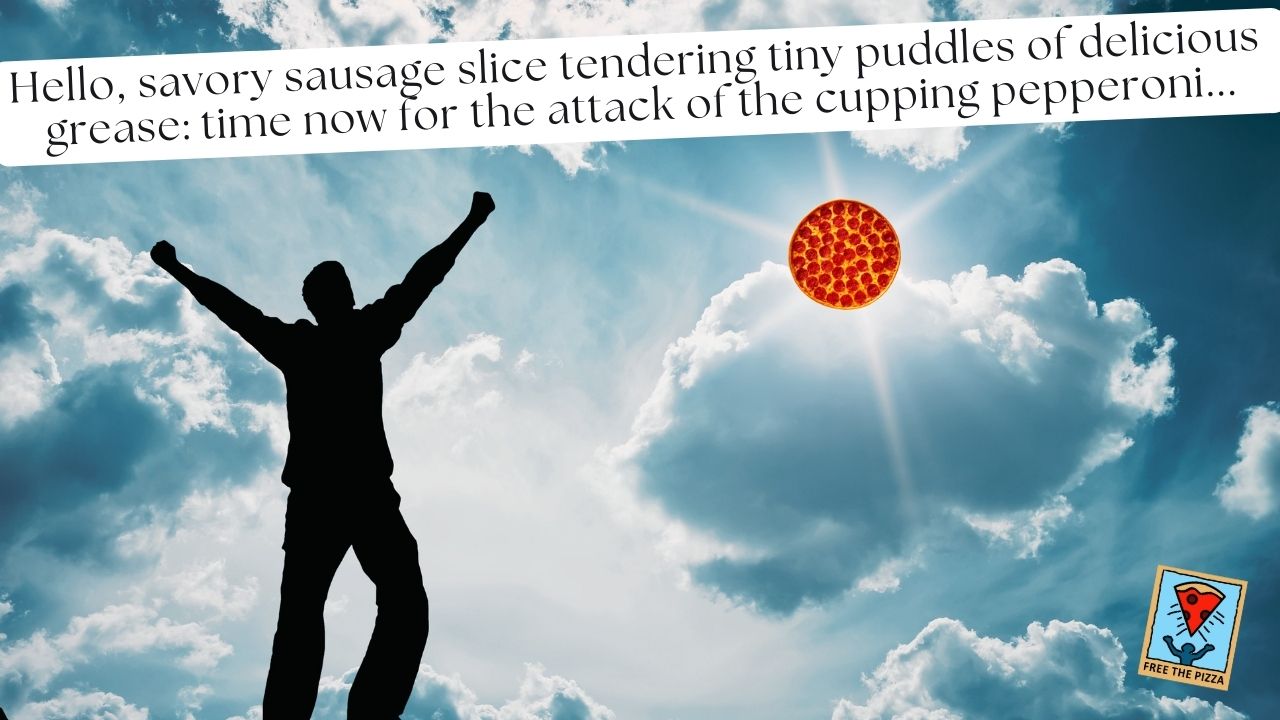|
Do you know what the world’s most popular topping pizza is? No, you don’t. Because the world is a big, crazy place with no two nation’s pizzas alike. But here in the US, where we think of ourselves as the center of the world, the favorite pizza topping by far is pepperoni. All the rage right now is the notorious cupping pepperoni. You see it all over social media: ongoing pizza porntography of strangers’ pizzas awash in fleshy red meat cups that have been sizzling in an oven and are brown around the edges and filled with rendered fat to the point where each individual pepporono (I’m pretty sure that’s not a word but it fits with my scant understanding Italian and Latin grammar regarding singular versus plural constructs and I’m going with it) is like a tiny hot tub filled with rendered grease colored red from the ingredients contained within the meaty mass of the cured sausage product. What is going on here? How does one encourage such glorious cupping behavior in our sliced cased meat products? The easy answer is: Buy a package of pepperoni that says “cupping pepperoni” on the label and go home. Thank you and goodnight!
Here now, a very brief and equally incomplete slice of the pepperoni story that contains more than you ever wanted to know. It begins not in Italy, but the United States. Pepperoni is not an Italian invention, contrary to what many think. Go to Italy and order a pepperoni pizza, and you’re going to get a pizza topped with red bell peppers. The word "pepperoni" is a borrowing of the Italian word peperoni, which is how Italians identify red bell peppers. It doesn’t matter whether the Italian red bell pepper wishes to identify as an American cured sausage product. Sorry, that’s just the way it goes. Their language and their rules in their country. Plus, Italians also seem to have an aversion to American-style pepperoni, despite all the greasy gustatorial goodness it brings to pizza. The Modernist Pizza folks apparently talked to Italian pizzaioli when they were in Italy. Said pizzaioli resisted all efforts at pepperoni persuasion. The cheffy people that the Modernistas are, they pointed out all the spicy fatty delights to no avail. It’s not clear who invented pepperoni, but it is quite clear that Hormel Foods was the power behind popularizing the product. It also seems the distinctive red color of their pepperoni is related to the cherry powder that is included to make it red. Meat, meet marketing! According to data collected nefariously through tracking our use of pizza ordering apps (a clear and present threat to personal privacy in favor of national security if there ever was one), 36% of all pizzas are ordered with pepperoni. Americans love their long, spicy cased meats. [Insert Freudian cigar joke here.] But the bigger question is wherefore cupping pepperoni? Why did it suddenly become all the rage and get home pizza people and casual consumers alike all agog over the little grease-pool creatures on their pizza? I blame it on social media and smartphone cameras. Because… It’s not a new thing. It’s old school. The reason pepperoni cups is simple: natural collagen casing, which holds the sausage together. When it’s cooked, the casing contracts. The sausage slice cups upward because it is attracted to the dominant heat source. The pizza beneath the pepperoni is not as hot as the top of the oven above it. The Modernistas actually did an experiment. (They do a lot of those, which is one reason the book is over 1,000 pages long and weighs 33 pounds.) They wanted to see what happened to cupping pepperoni if the dominant heat source was beneath it, and guess what: it cupped the other direction! Science! I’m trying to imagine the need for a pizza covered in little, dome-shaped pepperoni bumps and the marketing effort behind that one. Surely, Domino’s can figure out one more way to market novel applications of bread, cheese and salty cased meat products. It’s what they do. (Next up: Untied garlic knots stuffed with un-cupped pepperoni slices!) As you know, fat is flavor. So is salt. Put them together in a greasy little puddle in the bottom of a meaty slice of sausage and multiply by the dozens, and voila: International incident! A cultural appropriation of pizza proportions that makes Americans go mad and Italians shake their heads. Now, none of this means you have to go looking for a pepperoni that’s labeled as a cupping product. It just means that you have to determine if there’s a collagen casing. How do you do that? I have no idea. I just went to my own larder, where there are four unopened cased meat products. Only one of them mentions the casing, and that’s an artisan brand of dry chorizo. Presumably they are proud of their “natural casing” and include it on the ingredients list. There’s a brand of pepperoni in my fridge that cups quite nicely. None of the labeling says “cupping” or mentions the casing. In the absence of detailed labeling or marketing language, it seems we’re left to our own pepperoni devices. Recently, I departed from my standard “pepperoni alternative” stance to make a pepperoni pizza. I happen to like looking at alternatives for all kinds of things pizza, which is how I’ve ended up making pizzas like the deconstructed clam chowder pizza or the crowd-pleasing etouffée pizza. But one day, I was just in that mood where only a New York style pepperoni pizza slice would do. The local market had Hormel, which I have a bias against. This is a position born of ad-hoc taste tests. I would frequently have Hormel product and the generic Kroger store brand in one place, and I would ask people to do a blind taste test. 100% of the time, my subjects chose the Kroger store brand as tasting superior to the big national name. So, Hormel is my pepperoni of last resort. The store also had a brand I’d never heard of, bearing a German brand name. What could Germans possibly know about making faux-talian cased meat products? Certainly as much as Americans. The Germans are the kings of the wurst kind. I figured, Hey, let’s find out. Of course, close reading of the label showed the German heritage was only as deep as the corporate conglomerate culture of our friendly pork purveyors at Smithfield. So heritage is clearly just business and irrelevant. Interestingly, these pepperoni slices were thicker than the competition. I’m going to take a leap of pepperoni logic and infer that since Americans have a habit of overdoing their pizza toppings, the Hormel product is sliced thinner to make exercises in excess a less greasy endeavor. But this non-Teutonic German-named pepperoni was good. It curled up nicely and cupped an appropriate amount of grease and the edges browned and life sehr gut! It made me appreciate pepperoni again. A little background on my madness here. My pepperoni alternative stance came from asking why we’re we so married to one meat like this. Isn’t there something better? I stumbled on Spanish-style chorizo, and have tasted about half a dozen different brands. And while they don’t seem to do the cupping thing, they have a better flavor. And they often have a lower fat content, so the pizza is less greasy. No, it’s not dramatic. But it’s the subtle differences that start to help you develop your own pizza paradigm. There something in Korean culture called “tongue taste” and “hand taste.” Tongue taste is the basic flavors of whatever you’re eating. Much subtler is hand taste, which imparted by the cook who prepared what you’re eating. It’s the defining difference beyond the basics. Pizza example: If you look at pizza by Chris Bianco (Pizzeria Bianco) side-by-side with pizza by Nancy Silverton (Mozza), they look very similar. They have similar ingredients. Water, four, salt, yeast, tomato and cheese. But they are two clearly different animals. Their tongue tastes are similar. But the respective hand taste of Silverton and Bianco are distinctive. They’re both great. But each has a unique taste profile. How did we get to Korea from the US via Italy? Perhaps I need to rein in the digressions. But all this to say, pepperoni is a big part of pizza love for the American palate. Part of being your own pizzamaker is deciding how you’re going to address a staple ingredient like pepperoni. Cupping pepperoni is a fad with some sound reasons for its popularity. But what will you do with it? How will you handle your pepperoni? Learn what makes you happy and don’t feel beholden to the mob. Still waiting to start your homemade pizza journey? The silly little homemade pizza guide, Free The Pizza! (A Simple System For Making Great Pizza Whenever You Want With The Oven You Already Have), is ready and waiting to lead you astray.
0 Comments
Leave a Reply. |
AuthorBlaine Parker is the award-winning author of the bestselling, unusual and amusing how-to pizza book, Free The Pizza. Also known as The Pizza Geek and "Hey, Pizza Man!", Blaine is fanatical about the idea that true, pro-quality pizza can be made at home. His home. Your home. Anyone's home. After 20 years of honing his craft and making pizza in standard consumer ovens across the nation, he's sharing what he's learned with home cooks like you. Are you ready to pizza? Archives
July 2024
Categories
All
|
© Copyright 2021, 2022, 2023, 2024. All rights reserved.
As a ShareASale Affiliate and an Amazon Associate, we earn a small percentage from qualifying Amazon purchases at no additional cost to you.
When you click those links to Amazon (and a few other sites we work with), and you buy something, you are helping this website stay afloat, and you're helping us have many more glorious photographs of impressive pizza.
When you click those links to Amazon (and a few other sites we work with), and you buy something, you are helping this website stay afloat, and you're helping us have many more glorious photographs of impressive pizza.


 RSS Feed
RSS Feed